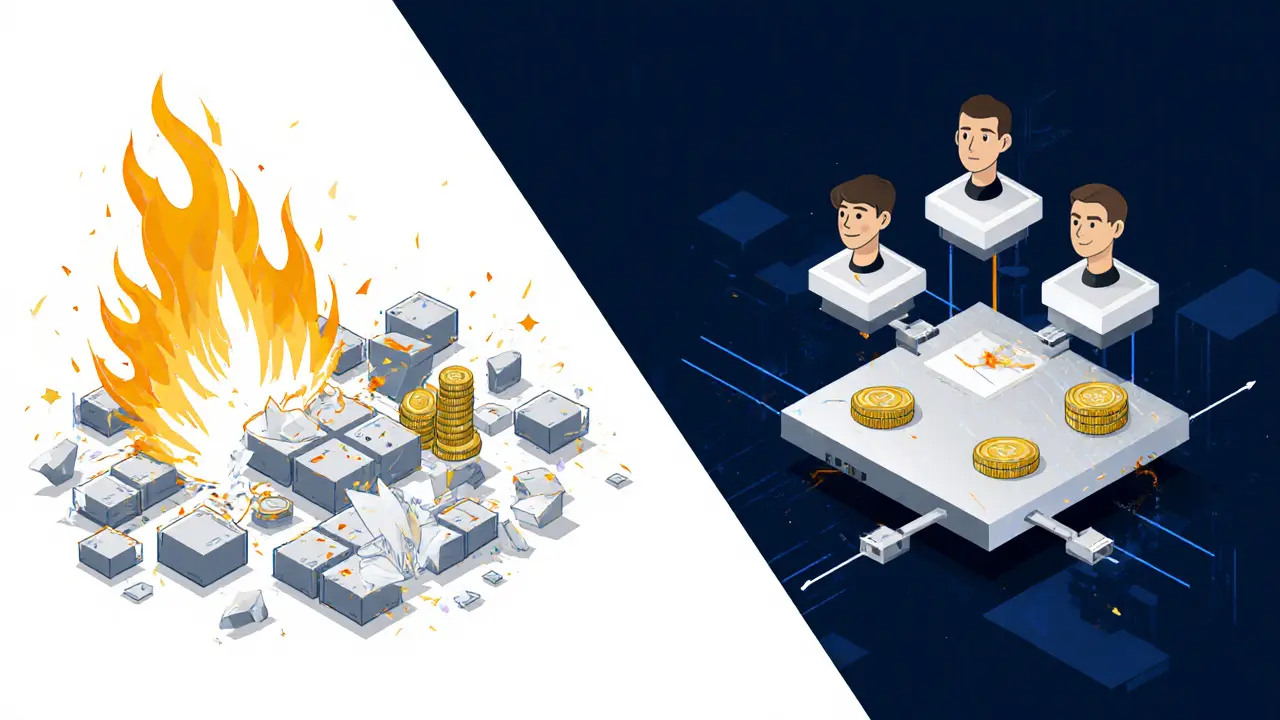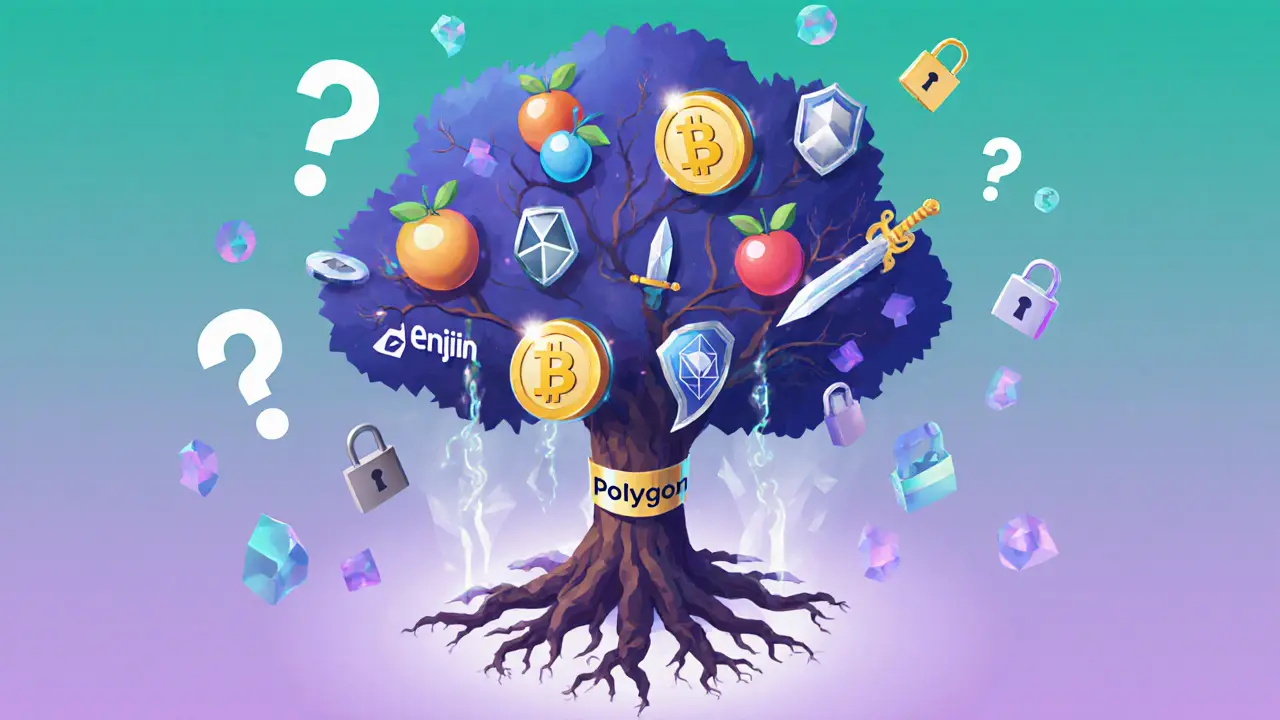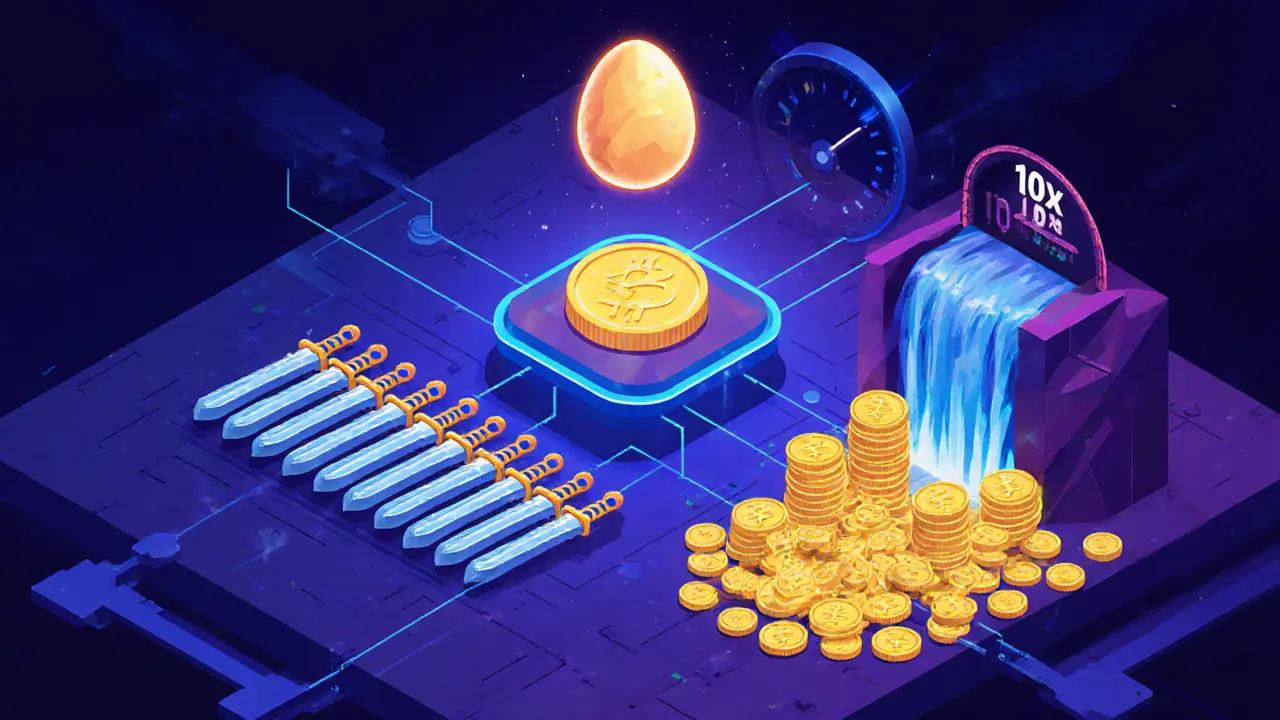ERC-1155 Gas Cost Calculator
Calculate how much gas you save by using ERC-1155 batch transfers instead of individual ERC-20/ERC-721 transfers. Based on real-world data from Enjin's benchmarks.
Gas Cost Comparison
SavingsImagine you're building a game where players can buy 10 identical swords, trade one rare dragon egg, and earn 500 gold coins-all in the same transaction. With older Ethereum standards, you’d need three separate smart contracts, three separate transactions, and pay gas fees for each one. That’s expensive, slow, and messy. ERC-1155 fixes that. It lets you manage all those token types-fungible, non-fungible, and semi-fungible-in a single contract. No more juggling multiple contracts. No more paying 10x the gas. This isn’t theory. It’s what top blockchain games use today.
What Exactly Is ERC-1155?
ERC-1155 is a smart contract standard on Ethereum that lets one contract handle multiple types of tokens at once. Before ERC-1155, you had two options: ERC-20 for coins (like ETH or USDC) and ERC-721 for unique NFTs (like CryptoKitties or Bored Apes). Each needed its own contract. If your project needed both, you had to deploy and manage two separate systems. That doubled your code, doubled your deployment cost, and made every transfer a separate gas bill.
ERC-1155 changes that. It uses a single contract with unique numeric IDs to represent each token type. One ID could be for 1,000 identical potions (fungible). Another ID could be for a one-of-a-kind sword (non-fungible). A third ID could be for 100 limited-edition shields-fungible until you upgrade one, then it becomes unique (semi-fungible). All of it lives in one place.
The standard was proposed in June 2018 by Witek Radomski from Enjin and became official in January 2019. It wasn’t just a tweak-it was a redesign. Instead of separate functions for each token type, ERC-1155 uses batch operations. You can send 5 different tokens to 3 different people in one transaction. That’s not convenience. That’s a 90% drop in gas costs, according to Enjin’s own benchmarks.
How ERC-1155 Works Under the Hood
At its core, ERC-1155 uses a two-layer mapping system: address => token ID => balance. For every wallet, it tracks how many of each token ID they hold. That’s different from ERC-721, which just checks if you own a token (true/false). ERC-1155 knows you have 12 of ID #456 and 1 of ID #888.
Here are the key functions:
balanceOf(address account, uint256 id)- Checks how many of a specific token ID a wallet has.balanceOfBatch(address[] accounts, uint256[] ids)- Checks balances for multiple wallets and token IDs in one call.safeTransferFrom(address from, address to, uint256 id, uint256 amount, bytes data)- Transfers a single token type with optional data.safeBatchTransferFrom(address from, address to, uint256[] ids, uint256[] amounts, bytes data)- Transfers multiple token types in one go.
Batch transfers are where the magic happens. Sending 10 different tokens individually using ERC-20 or ERC-721 would cost over 450,000 gas. With ERC-1155’s batch function? Around 115,000 gas. That’s not a small saving-it’s a game-changer for apps that move lots of assets, like games or marketplaces.
Metadata is stored per token ID, not per contract. So each sword, potion, or dragon egg can have its own image, name, and description, all from the same contract. This gives developers fine control without bloating the code.
Why ERC-1155 Beats ERC-20 and ERC-721 in Gaming
Let’s say you’re making a fantasy RPG. You need:
- 1,000 identical healing potions (fungible)
- 50 unique enchanted armor sets (non-fungible)
- 100 silver swords that can be upgraded into unique gold swords (semi-fungible)
With ERC-721, you’d need 1,000+ separate contracts for the potions. With ERC-20, you can’t handle the armor. With ERC-1155? One contract. One deployment. One gas bill.
Enjin used ERC-1155 in their Minecraft plugin. They managed over 1.2 million in-game asset transfers with 92% lower gas costs than using separate ERC-20 and ERC-721 contracts. That’s not marketing-it’s real savings.
Market data backs this up. DappRadar found that 73% of new blockchain gaming projects in Q2 2023 used ERC-1155, up from just 41% in 2021. Deloitte’s survey of 250 gaming companies showed 87% use it for at least some assets. Why? Because games are complex. Players trade, upgrade, combine, and sell. ERC-1155 was built for that chaos.
Compare that to ERC-721, which still dominates pure art NFTs (72% market share). Why? Because art collections don’t need batch transfers or fungible tokens. They’re simple: one NFT, one owner. ERC-721 is clean for that. But for anything with economy mechanics? ERC-1155 wins.

The Downsides: Complexity and Security Risks
ERC-1155 isn’t magic. It’s powerful, but harder to get right.
First, the learning curve. If you know ERC-20 and ERC-721, you still need 15-25 hours to master ERC-1155. The batch functions, the onERC1155Received hook, the token ID management-all add layers of complexity. Developers on Reddit and GitHub report spending weeks debugging metadata display issues on marketplaces. One developer said it added 20 extra hours to their project timeline.
Second, security. OpenZeppelin’s 2022 audit found 68% of ERC-1155 contracts had at least one moderate-severity flaw-mostly around access control and input validation. That’s worse than ERC-721’s 52%. Why? Because more features = more ways to mess up.
There were real consequences. In 2021, a gaming platform lost $250,000 because their contract didn’t properly validate token IDs during transfers. Hackers exploited that gap. Chainalysis reported that 12% of all token exploits in 2022 involved ERC-1155-though that’s down from 18% in 2021 as best practices improve.
The fix? Use OpenZeppelin’s official implementation. It’s used in 89% of deployed ERC-1155 contracts. Don’t write your own unless you’re an expert. And always test batch transfers with real gas estimates before launch.
Who’s Using ERC-1155 Today?
It’s not just small projects. Big names are all in:
- Enjin - Built their entire ecosystem on it. Their SDK powers games on Ethereum, Polygon, and BNB Chain.
- OpenSea - Supports ERC-1155 for collections that mix NFTs and fungible tokens (like in-game currency packs).
- Polygon and BNB Chain - Native support. Low fees make ERC-1155 even more attractive here.
- Fortune 500 companies - 43 are testing it for loyalty programs and supply chain tracking, where one asset might be a tokenized crate (fungible) and another a unique certificate (NFT).
Even outside gaming, it’s growing. A logistics firm in Germany uses ERC-1155 to track 10,000 identical shipping containers (fungible) and 50 unique high-value cargo units (NFTs) in one system. A university in Canada uses it to issue diplomas (NFTs) and course credits (fungible tokens) to students.

What’s Next for ERC-1155?
The future is bright. OpenZeppelin’s latest update (v4.8.0, May 2023) added better gas optimizations and clearer error messages. The Ethereum Foundation plans to integrate ERC-1155 with account abstraction (ERC-4337) by 2025. That could cut transfer gas by another 30-40%-making it even cheaper to move assets.
Gartner predicts ERC-1155 will power 55% of all blockchain gaming asset transfers by 2025. That’s up from 38% in 2023. Why? Because games are getting more complex. Players want to trade, merge, and upgrade. ERC-1155 is the only standard built for that.
There are also community proposals to improve it. EIP-6059, for example, aims to make metadata handling more consistent across marketplaces. Right now, displaying an ERC-1155 NFT on OpenSea vs. LooksRare can be a headache. That’s changing.
And it’s spreading beyond Ethereum. NEAR Protocol and Binance Smart Chain now have their own versions. The standard is becoming universal.
Should You Use ERC-1155?
Ask yourself:
- Do you need more than one type of token? (fungible + NFT + semi-fungible)
- Will users transfer multiple assets at once?
- Are gas costs a big concern?
If yes, then ERC-1155 is your best bet. Use OpenZeppelin’s implementation. Don’t reinvent the wheel. Test batch transfers. Watch your token ID allocation. Read the docs.
If you only need one token type-say, just coins or just art NFTs-stick with ERC-20 or ERC-721. Simpler is better. Don’t force complexity where it’s not needed.
ERC-1155 isn’t the future of all tokens. It’s the future of complex, multi-asset systems. And that’s where the real innovation is happening.
What’s the difference between ERC-1155 and ERC-721?
ERC-721 handles only non-fungible tokens (one-of-a-kind items). ERC-1155 can handle fungible tokens (like coins), non-fungible tokens (like NFTs), and semi-fungible tokens (like limited-edition items) all in one contract. ERC-721 needs a separate contract for each NFT collection. ERC-1155 uses one contract for many types of assets.
Is ERC-1155 better than ERC-20 for coins?
Not really. ERC-20 is simpler and supports decimals (like 0.001 ETH), while ERC-1155 only works with whole numbers. If you only need a coin, use ERC-20. But if you also need NFTs in the same app, ERC-1155 lets you combine them without extra contracts.
Can I convert ERC-721 NFTs to ERC-1155?
Not directly. They’re different standards. You’d need to migrate assets by creating new ERC-1155 tokens and transferring ownership. Some marketplaces offer migration tools, but it’s not automatic. Always back up your NFTs before attempting a move.
Why do some marketplaces not display ERC-1155 NFTs correctly?
Because metadata handling isn’t fully standardized. Each ERC-1155 token can have its own URI, but not all platforms parse it the same way. Some expect metadata in a specific format. Developers often need custom code to make ERC-1155 NFTs show up properly on OpenSea, Blur, or others.
How much gas does an ERC-1155 batch transfer save?
Transferring 10 different tokens individually using ERC-20 or ERC-721 costs around 450,000+ gas. With ERC-1155’s batch transfer, it drops to about 115,000 gas. That’s a 74% reduction. For projects with high transaction volume, that’s thousands of dollars saved per month.
Is ERC-1155 secure?
It can be, but it’s riskier than ERC-20 or ERC-721 if not implemented correctly. The added complexity introduces more attack surfaces. Always use OpenZeppelin’s audited implementation. Avoid custom code. Test batch transfers thoroughly. Most exploits happen because devs skip these steps.
What’s a semi-fungible token in ERC-1155?
A semi-fungible token starts as interchangeable (like 100 identical swords), but once you upgrade or modify one, it becomes unique. For example, a bronze sword with ID #100 might become a silver sword with a custom name after a quest. The token ID stays the same, but its properties change. ERC-1155 lets you model that in code.
Can I use ERC-1155 on networks other than Ethereum?
Yes. It’s been adopted on Polygon, BNB Chain, Avalanche, NEAR Protocol, and others. Since these chains are EVM-compatible (or have similar standards), ERC-1155 contracts work with minimal changes. That’s why it’s the go-to for cross-chain gaming projects.

Rebecca Amy
November 15, 2025 AT 04:51Ugh, another ‘ERC-1155 is magic’ post. I’ve seen this 10x on Reddit. Yeah, it saves gas… until your metadata breaks on OpenSea and you spend 3 days debugging why your NFTs show up as ‘undefined’ 😩
Kathleen Bauer
November 17, 2025 AT 00:40lol i just use erc-1155 for my rpg and it’s been smooth af 🤙 no more juggling 3 contracts. even my 12-year-old cousin got it working. you guys overcomplicate stuff
Carol Rice
November 17, 2025 AT 03:54STOP. STOP. STOP. This isn’t ‘just another standard’-this is THE revolution in blockchain gaming! You’re not ‘saving gas’-you’re unlocking entire economies! Imagine 10,000 players trading potions, armor, AND currency in ONE transaction-NO MORE WAITING! NO MORE BLOATED TX FEES! This isn’t coding-it’s liberation!!!
satish gedam
November 18, 2025 AT 18:35Great write-up! I used this in my Unity game on Polygon and gas dropped from $8 to $0.60 per transaction. Also, OpenZeppelin’s implementation saved me from a nasty reentrancy bug 🙏
Jerrad Kyle
November 19, 2025 AT 16:53As someone who’s shipped games in Japan and the US, ERC-1155 is the only way to handle in-game economies without making players hate blockchain. The semi-fungible upgrade system? Pure genius. It mirrors how physical items evolve in real life.
nikhil .m445
November 21, 2025 AT 00:49Actually, your understanding of ERC-1155 is superficial. You mention batch transfers but ignore the fact that the onERC1155Received hook requires strict adherence to EIP-165. Most developers don’t implement it correctly and create silent failures. This is amateur hour.
Rick Mendoza
November 21, 2025 AT 23:35ERC-1155 is overhyped. If you need multiple token types you’re doing it wrong. Just use two contracts. Simpler. Safer. Less cognitive load. You’re not building NASA software
Barbara Kiss
November 22, 2025 AT 06:39There’s something poetic about how ERC-1155 mirrors human value systems-some things are interchangeable, some are sacred, and some become unique through experience. It’s not just code. It’s a metaphor for identity in digital spaces.
Aryan Juned
November 23, 2025 AT 21:21Bro this is why I hate Ethereum devs. You make everything so complicated. I just want to buy a sword and a potion. Why do I need to understand ‘semi-fungible’? Why can’t we just have a simple app? 😭
Nataly Soares da Mota
November 25, 2025 AT 20:21The ontological implications of ERC-1155’s token ID mapping are staggering. It collapses the Aristotelian substance-accident dichotomy into a single state machine. The fungible/non-fungible continuum becomes a dynamic manifold-each balance a vector in a multidimensional ownership space.
Darren Jones
November 26, 2025 AT 18:30For anyone starting out: use OpenZeppelin’s ERC1155 contract. Don’t write your own. Seriously. I lost 48 hours debugging a missing ‘_exists(id)’ check. The docs are clear-just follow them.
Laura Lauwereins
November 26, 2025 AT 19:42Wow. So you’re telling me the solution to ‘too many contracts’ is… one contract? Groundbreaking. Next you’ll tell me water is wet and gravity exists. 🤡
Gaurang Kulkarni
November 27, 2025 AT 09:54ERC-1155 is a disaster waiting to happen. You think you’re saving gas but you’re creating a single point of failure. One bug and your entire economy collapses. And you think the 74% gas saving matters when your users lose $50k worth of items because you didn’t validate the batch array length? Wake up
Nidhi Gaur
November 28, 2025 AT 02:34Used this for my indie game and it’s been a lifesaver! My players love being able to trade 5 items at once. Also, the metadata thing? Just use IPFS and stick to the standard format. No drama 😊
Usnish Guha
November 29, 2025 AT 08:52Anyone using ERC-1155 without a formal audit is a liability to the ecosystem. You think you’re being efficient but you’re just enabling rug pulls. This isn’t a hobby project-it’s real money. Get certified or stay out
rahul saha
December 1, 2025 AT 00:52man i tried erc-1155 and my head exploded. why does a sword need a URI? why cant it just be a sword? i miss the days when games just had inventory slots 😭
Marcia Birgen
December 2, 2025 AT 23:35Hey everyone-just want to say thank you to the devs who made this possible. I’m a teacher and I use ERC-1155 to give students digital badges + course credits. It’s beautiful how one standard can bridge learning and ownership. Keep going!
Usama Ahmad
December 4, 2025 AT 21:36Same here! Used it for a small marketplace. Gas costs dropped 80%. No issues. Just follow the docs and you’ll be fine.
Nathan Ross
December 5, 2025 AT 02:29While the technical merits of ERC-1155 are undeniable, one must consider the epistemological burden placed upon end-users. The ontological ambiguity inherent in semi-fungible token states introduces a metaphysical dissonance incompatible with intuitive user experience paradigms. A more minimalist approach may yield superior long-term adoption.